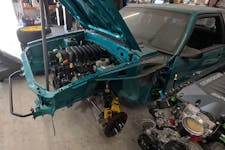In 1979, Ford introduced the world to the Fox-body Mustang, based on an all-new, cutting edge lightweight chassis. While the Mustang made the Fox-chassis famous, Ford actually used it on a number of 1980s cars, including the Thunderbird, Mercury Cougar, and the oft-forgotten Ford Fairmont, a classy mid-size sedan that only lasted a single generation.
But the Fairmont has a small-yet-devoted following of fans who still modify this old sedan, including some of the guys at LateModelRestoration.com. They took a 1979 vintage Fairmont two-door sedan and dropped one of Ford Racing’s 4.6 liter mod motor V-8s under its long hood. This video gives us a small taste of what this wicked combo is capable of.
 But since the Ford 4.6 wasn’t even available in the same decade as Fairmont sales, surely this must have been a difficult swap, right? Well thanks to Ford’s new standalone ECU system on their “hot rod” 3-valve 4.6 liter V8 crate engine, dropping this engine between the frame rails was a relatively simple affair.
But since the Ford 4.6 wasn’t even available in the same decade as Fairmont sales, surely this must have been a difficult swap, right? Well thanks to Ford’s new standalone ECU system on their “hot rod” 3-valve 4.6 liter V8 crate engine, dropping this engine between the frame rails was a relatively simple affair.
A simplified harness from Ford Racing allowed for the setup to run in just about any 12-volt electrical system, and minus a fuel system and transmission, the motor came with everything necessary to get this ride on the road. LateModelRestoration.com added a BBK X-pipe and Mac Long Tube headers, but this motor makes plenty of power as-is. Besides, this build is from 2009, before the new Coyote engine had hit the streets.
The Fairmont is not a car that gets a lot of love, but with the 3-valve hot rod motor, it screams down the track, pulling high-11s and putting 322 horsepower to the wheels. While we love the use of the 4.6 mod motor, we’d really like to see a new Coyote 5.0 setup in a Fairmont. Can you imagine how fast that boxy sedan would go with one of those engines up front? We think the Fairmont is due for an engine upgrade, don’t you agree?
You might also like
Make Your Mustang GTD Extra Super With Forged Magnesium Wheels
Mustang GTD owners seeking more performance and style have an option. Litespeed Racing created magnesium wheel designs for the supercar.






